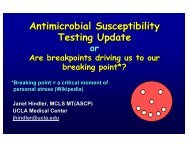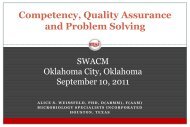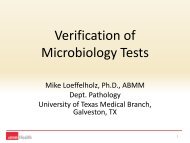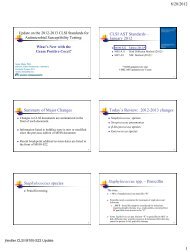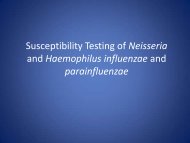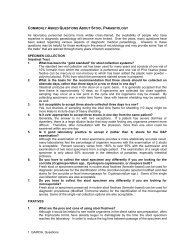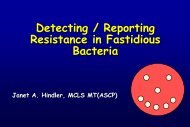The Evolving Threat of ESBL, AmpC, and KPC -lactamases - SWACM
The Evolving Threat of ESBL, AmpC, and KPC -lactamases - SWACM
The Evolving Threat of ESBL, AmpC, and KPC -lactamases - SWACM
Create successful ePaper yourself
Turn your PDF publications into a flip-book with our unique Google optimized e-Paper software.
<strong>The</strong> <strong>Evolving</strong> <strong>Threat</strong> <strong>of</strong> <strong>ESBL</strong>,<br />
<strong>AmpC</strong>, <strong>and</strong> <strong>KPC</strong> -<strong>lactamases</strong><br />
Philip Lister, Ph.D.<br />
Pr<strong>of</strong>essor, Medical Microbiology <strong>and</strong> Immunology<br />
Creighton University School <strong>of</strong> Medicine
Klebsiella pneumoniae 225<br />
Resistant<br />
Penicillins<br />
Penicillin-inhibitor combinations<br />
1st & 2nd gen cephalosporins<br />
ceftriaxone, cefotaxime, ceftazidime, aztreonam<br />
cefoxitin<br />
aminoglycosides, trimethoprim/sulfa, chloramphenicol<br />
Susceptible<br />
Imipenem <strong>and</strong> fluoroquinolones
Normal<br />
Gram-negative
Resistance Mechanisms<br />
Inactivating Enzymes<br />
Alterations in Target<br />
Altered Permeability<br />
Outermembrane Porins<br />
Active Efflux
ß-<strong>lactamases</strong><br />
O<br />
CH 2 C NH<br />
O<br />
N<br />
S<br />
CH 3<br />
CH 3<br />
COOH<br />
Site <strong>of</strong> Action
L<br />
Gram-negative<br />
L<br />
L<br />
L<br />
L<br />
L<br />
L<br />
Beta-lactamase<br />
Production<br />
L<br />
L
Old Plasmid-Encoded ß-<strong>lactamases</strong><br />
TEM-1<br />
Ampicillin resistance E. coli <strong>and</strong> H. influenzae<br />
Penicillin resistance N. gonorrhoeae<br />
TEM-2<br />
Similar to TEM-1<br />
SHV-1<br />
Cephalothin resistance K. pneumoniae
Attempts to Circumvent<br />
Plasmid-Encoded ß-<strong>lactamases</strong><br />
-lactamase Inhibitors<br />
Enzyme-Resistant Drugs
3 rd Generation Cephalosporins<br />
Cefotaxime<br />
Ceftriaxone<br />
Ceftazidime
Plasmid-Encoded ß-lactamase Evolution<br />
among E. coli <strong>and</strong> K. pneumoniae<br />
TEM-1<br />
TEM-2<br />
SHV-1<br />
Acquire Active Enzyme<br />
Mutate Own Enzyme<br />
Extended-Spectrum<br />
Beta-<strong>lactamases</strong>
Evolution <strong>of</strong> <strong>ESBL</strong>s<br />
TEM-3, 4 ......…………....178<br />
SHV-2, 3 ...………….......134<br />
CTX-M-1, 2……………….113<br />
OXA-2, 10……………......161
Failures <strong>of</strong> Cephalosporin <strong>The</strong>rapy<br />
in Serious Infections with<br />
<strong>ESBL</strong>-positive K. pneumoniae<br />
Isolates reported susceptible to the cephalosporins<br />
Cephalosporin failed in 15/28 (54%) patients<br />
4 <strong>of</strong> 5 were treated with cefepime!<br />
D. Paterson et al JCM (2001) 39: 2206-2212
<strong>ESBL</strong>-producing Organisms<br />
Most Common<br />
E. coli, Klebsiella spp.<br />
Less frequent but clinically significant<br />
Proteus, Citrobacter, Enterobacter,<br />
M. morganii,, Prov. stuartii, Salmonella,<br />
S. marcescens, Shigella, P. aeruginosa,<br />
A. baumannii, A. hydrophila, B. cepacia etc.
New CLSI Breakpoints<br />
Susceptible Breakpoint Lowered 2010 (M100-S20)<br />
Cefazolin, cefotaxime, ceftriaxone, ceftizoxime (< 1 µg/ml)<br />
Ceftazidime, aztreonam (< 4 µg/ml)<br />
No Change in Breakpoint (M100-S20)<br />
Cefepime (< 8 µg/ml)
CLSI 2010 (M100-S20)<br />
• If laboratories have not yet implemented the new<br />
interpretive criteria, test for <strong>ESBL</strong>s. For positive<br />
isolates:<br />
Report resistance to all penicillins, cephalosporins<br />
<strong>and</strong> aztreonam if E. coli, Klebsiella spp, or Proteus<br />
mirabilis<br />
• If laboratories have implemented the new criteria, do<br />
not test for <strong>ESBL</strong>s for therapy (Only test if required<br />
for infection control)<br />
Report susceptibility as interpreted
Many <strong>ESBL</strong> Producers Previously Reported<br />
Resistant to Cefepime Now “Susceptible”<br />
157 <strong>ESBL</strong>-positive<br />
E. coli, K. pneumoniae, K. oxytoca<br />
MIC in µg/ml<br />
< 8<br />
< 1<br />
% Susceptible<br />
77%<br />
34%<br />
63 U.S. Sites – <strong>ESBL</strong>-positive by phenotypic, IEF & molecular testing<br />
Mol<strong>and</strong>, Hanson, Black, Hossain, Song, & Thomson, 2006, J Clin Microbiol 44:3318-3324
2010 Breakpoints:<br />
Are they sufficient?<br />
• MIC 2 µg/ml: cefepime failure, meropenem cure<br />
• MIC 0.5 µg/ml: cefepime + gent 5 days, died<br />
Paterson et al 2001 J Clin Microbiol 39:2206-2212<br />
• MIC 4 µg/ml: cefepime failure<br />
Bhavnani 2006 Diagn Microbiol Infect Dis 54:231-236<br />
• MIC 0.75 µg/ml: cefotaxime failure, cured with<br />
cipr<strong>of</strong>loxacin<br />
Karas et al 1996 J Antimicrob Chemother 37:203-204
Inoculum Effect:<br />
Are Cephalosporin MICs Accurate<br />
E. coli Microdilution MIC in µg/ml<br />
Enzyme Inoculum Cefotaxime Cefepime Imipenem<br />
SHV-3 5 x 10 5 8 2 0.06<br />
SHV-3 5 x 10 7 1024 1024 0.5<br />
19
Inoculum Effect:<br />
In Vitro Artifact?<br />
Treated infections 15 days with PIP, IPM, CAZ, or ATM<br />
Measured <strong>AmpC</strong> activity in sputum samples days 1 <strong>and</strong> 15<br />
Significant rise in <strong>AmpC</strong> activity in sputum <strong>of</strong> patients<br />
treated with PIP, IPM, or CAZ.<br />
No <strong>AmpC</strong> activity detected in the day 15 sputum <strong>of</strong> 19/21<br />
patients treated with ATM.<br />
Overnight dialysis, significant amounts <strong>of</strong> <strong>AmpC</strong> detected.<br />
Competitive inhibition by aztreonam was masking<br />
extracellular <strong>AmpC</strong><br />
Gwicerman et al., AAC 1992;36:71
<strong>ESBL</strong>-producing bacteria resistant to:<br />
Penicillins<br />
Cephalosporins<br />
Aztreonam<br />
Penicillin-inhibitor combinations<br />
Aminoglycosides<br />
Trimethoprim<br />
Sulfonamides<br />
Fluoroquinolones
-lactams Still Active<br />
Carbapenems<br />
Cefoxitin
Plasmid-Encoded ß-lactamase Evolution<br />
among E. coli <strong>and</strong> K. pneumoniae<br />
TEM-1<br />
TEM-2<br />
SHV-1<br />
Acquire Active Enzyme<br />
Plasmid <strong>AmpC</strong><br />
Mutate Own Enzyme<br />
Extended-Spectrum<br />
Beta-<strong>lactamases</strong>
<strong>AmpC</strong>-mediated Resistance<br />
Resistant to<br />
Cephalosporins (1st, 2nd, 3rd gen)<br />
Cephamycins<br />
Aztreonam<br />
Penicillins<br />
β-lactamase inhibitor combinations<br />
Susceptible to<br />
Carbapenems<br />
Cefepime?
Inducible Chromosomal <strong>AmpC</strong><br />
Enterobacter spp.<br />
Serratia spp.<br />
Citrobacter freundii<br />
Providencia spp.<br />
Morganella morganii<br />
Hafnia alvei<br />
Pseudomonas aeruginosa<br />
Aeromonas spp.
Plasmid-mediated <strong>AmpC</strong>s<br />
• Klebsiella spp., E. coli, Salmonella, P. mirabilis,<br />
P. aeruginosa<br />
• Derived from chromosomal <strong>AmpC</strong>s<br />
• Different Families (DHA, CMY, FOX most<br />
common)
Plasmid-encoded <strong>AmpC</strong> Challenges<br />
Detection<br />
False susceptibility<br />
Development <strong>of</strong> carbapenem resistance
Clinical Significance <strong>of</strong> <strong>AmpC</strong> for<br />
K. pneumoniae Bloodstream Isolates<br />
Clinical<br />
DHA-1<br />
(inducible)<br />
CMY-1 like<br />
Extended-spectrum<br />
Cephalosporin as<br />
definitive therapy<br />
Failed CTX/CAZ;<br />
improved on<br />
carbapenem<br />
4/4 died 1/3 died<br />
6 5<br />
30 day mortality 46% 14.3%<br />
DHA-1 (13 pts), CMY (14 pts) Pai et al. AAC 2004 48:3720-28
K. pneumoniae: DHA-1 + Porin Loss<br />
• 11 pts infected – all carbapenem-resistant (MDR)<br />
2 improved with antibiotic Rx<br />
9/11 died in 30 days (81.8%)<br />
• Risk factors<br />
Infection by DHA-1 K. pneumoniae<br />
Carbapenem Rx in previous 3 months<br />
Advanced Age<br />
Long hospital stay<br />
Pers. comm. S. H. Jeong,<br />
Yonsei Univ. College Med. Seoul, Korea
Klebsiella pneumoniae 225<br />
Resistant<br />
Penicillins<br />
Penicillin-inhibitor combinations<br />
1st & 2nd gen cephalosporins<br />
ceftriaxone, cefotaxime, ceftazidime, aztreonam<br />
cefoxitin<br />
aminoglycosides, trimethoprim/sulfa, chloramphenicol<br />
Susceptible<br />
Imipenem <strong>and</strong> fluoroquinolones
Klebsiella pneumoniae 225<br />
Isoelectric<br />
Point<br />
Clavulanate<br />
Sensitivity<br />
Enzyme<br />
5.4 S TEM-1<br />
6.8 S OXA-9<br />
7.6 S SHV-2 (<strong>ESBL</strong>)<br />
8.2 S SHV-5 (<strong>ESBL</strong>)<br />
9.3 R ACT-1 (<strong>AmpC</strong>)<br />
All genes on the same 90 kb plasmid, other unrelated resistance genes
Carbapenemases<br />
Class A (<strong>KPC</strong>, GES, SME etc.)<br />
Serine-based<br />
Hydrolyze all β-lactams (variability)<br />
Inhibited by clavulanate<br />
Class B (Metallo-β-<strong>lactamases</strong> - IMP, VIM, NDM etc.)<br />
Require zinc for activity<br />
Hydrolyze carbapenems rapidly<br />
Hydrolyze all β-lactams except aztreonam<br />
Resistant to clavulanate<br />
Class D (some OXAs)<br />
Poorly inhibited by clavulanate<br />
Acinetobacter, P. aeruginosa, some Enterobacteriaceae
Klebsiella pneumoniae Carbapenemase (<strong>KPC</strong>)<br />
• First reported in 2001 from an isolate in NC<br />
• Very rapid spread<br />
• 10 variants (<strong>KPC</strong>-2 through <strong>KPC</strong>-11)<br />
• Endemic in Northeastern USA, Puerto Rico, Colombia,<br />
Israel, <strong>and</strong> Greece<br />
• K. pneumoniae, other Enterobacteriaceae,<br />
Acinetobacter, P. aeruginosa<br />
• <strong>ESBL</strong> that also hydrolyzes carbapenems<br />
• Extensive multidrug resistance
Miami <strong>KPC</strong> Outbreak<br />
• Admission file: XDR K. pneumoniae<br />
• Ignored<br />
• S to only colistin & gentamicin: PCR = <strong>KPC</strong> positive<br />
• 9 more pts over 3 months (8 identical PFGE type)<br />
• Clinical Impact:<br />
4/5 with bacteremia died<br />
1 other died<br />
2 renal failure<br />
Michelle Morris, University <strong>of</strong> Miami Hospital<br />
ICAAC/IDSA 2008, K-902<br />
36
CLSI Carbapenem Testing: Enterobacteriaceae<br />
• 2010 Susceptible Breakpoints (supplement to M100-S20)<br />
• Doripenem, imipenem, meropenem < 1 µg/ml<br />
• Ertapenem < 0.25 µg/ml (to be reviewed)<br />
• No carbapenemase test for therapy<br />
• If New Breakpoints Not Used, Screen <strong>and</strong> Confirm All Types<br />
<strong>of</strong> Carbapenemases (M100-S19)<br />
• Screen – MIC 2 ertapenem, 2-4 imipenem/meropenem<br />
plus<br />
• Resistance to cefotaxime, ceftriaxone, ceftazidime,<br />
cefoperazone or ceftizoxime<br />
• Confirmation – “Modified Hodge Test”<br />
• If positive <strong>and</strong> isolate is carbapenem-susceptible, report MIC<br />
without interpretation<br />
37
Which MIC do we use?<br />
Carbapenem MICs against <strong>KPC</strong><br />
producers vary significantly between<br />
microdilution, Etest, agar dilution, disk<br />
diffusion, <strong>and</strong> automated assays<br />
Pournaras et al 2010 J Clin Microbiol 48:2601-2604<br />
Bratu et al 2005<br />
Antimicrob Agents Chemother 49:776-778<br />
Antimicrob Agents Chemother 49:3018-3020<br />
Arch Intern Med 165:1430-1435<br />
Samra et al. 2007 IJAA 30:525-529
<strong>KPC</strong>-producing K. pneumoniae:<br />
Carbapenem MICs (µg/ml)<br />
Isolate Method Meropenem Ertapenem<br />
12 VITEK 2 >16 4<br />
BD Phoenix 4<br />
Agar Dilution 16 16<br />
48 VITEK 2 >16
Thanks for your attention!



